Picture this: a customer fills out your post-purchase survey, frustrated about a late delivery. A week later, they reach out to your support team with the same complaint. Days later, they leave a negative review online. Three different channels, three separate cries for help — but because the data sits in silos, no one connects the dots.
From the customer’s perspective, it feels like shouting into the void. From the company’s perspective, it’s death by a thousand paper cuts: duplicated complaints, missed opportunities to resolve issues early, and a growing sense of customer distrust.
This is the hidden cost of feedback silos in customer experience. And it’s far more common than you think. Our recent AI in Feedback Analytics 2025 research found that 93% of CX leaders struggle with fragmented feedback scattered across multiple systems. Even more telling, 87% still rely on manual verbatim analysis, combing through endless comments in spreadsheets while critical issues slip through.
The result? Teams react too slowly, frontline staff remain blind to customer pain, and organizations lose the very trust they’re trying to build. In an era where personalization, proactive service, and real-time responsiveness define great CX, siloed feedback isn’t just an operational hiccup — it’s the biggest blocker to transformation.
In this blog, we’ll unpack what feedback silos really are, why they exist, and most importantly, how they silently hold your customer experience back. Let's get started!
TL;DR
- Feedback silos — disconnected surveys, tickets, and reviews — lead to blind spots, repeated customer pain, and missed opportunities to act.
- These silos exist not because teams don’t care, but because data lives across tools, taxonomies don’t align, and ownership is unclear.
- The cost of inaction is high: slow insights, generic fixes, and customers who stop believing their feedback makes a difference.
- If your feedback arrives late, lives in spreadsheets, and doesn’t reach the right team — you’ve got a signal flow problem.
- Fixing it means building a unified feedback engine powered by AI — one that connects data, detects what matters, routes it instantly, and closes the loop fast.
- Metrics like Signal-to-Action ratio, time-to-insight, and % feedback auto-routed with owners are the new signs of CX maturity.
- Zonka Feedback’s AI Feedback Intelligence turns scattered customer signals into prioritized, accountable actions with features like multi-source consolidation, AI-based theme and sentiment tagging, real-time alerts, role-based workflows, and KPI tracking, it’s built for CX teams that want to move fast and prove impact. Book a demo today and see it in action.
Turn Feedback Silos into Smart CX Wins with AI Feedback Intelligence📈
Uncover themes, sentiment, and drivers at scale with Zonka Feedback’s AI Feedback Intelligence. Turn raw feedback into roadmaps, retention strategies, and measurable impact.

What Are Feedback Silos & Why They’re Sabotaging Your CX?
Let’s be honest, you don’t wake up thinking, “How’s our feedback taxonomy today?”
But if you’ve ever found yourself wondering why your NPS is dropping despite glowing support reviews, or why you’re still hearing the same customer complaints month after months, chances are, you’re dealing with feedback silos. So, what exactly are feedback silos?
They’re what happens when customer feedback gets trapped in disconnected systems, your survey platform, support desk, review sites, chat tools, maybe even social media. All of it valuable. None of it unified.
Instead of a single, flowing narrative about your customer’s experience, you get fragments. Different teams holding different pieces of the puzzle. And no one sees the full picture.
What this looks like on the ground? You probably already know this pain:
- Your CX dashboard shows CSAT improving but your rating is tanking
- Product gets survey feedback but generally weeks later
- Support tickets highlight churn signals but no one’s correlating them with feedback from the onboarding survey
- Social media comments are being triaged by Marketing, but not flagged to Ops when a delivery issue is trending
- Customer complaints are logged 3 different ways by 3 different teams — with no unified theme tagging
Why Do Feedback Silos Stick Around?
Here’s the hard truth: it’s not that you’re ignoring the problem, it’s that most CX ecosystems weren’t built to work together in the first place. They evolved in isolation. Every team got their own tools, goals, and workflows. And over time, those invisible walls became hardwired into your operations.
Let’s break down what’s really going on:
- Each team speaks a different feedback language: Support optimizes for resolution time. Marketing tracks review ratings. Product cares about feature requests. Everyone’s looking at feedback — but through a different lens, in a different tool, with different KPIs. No wonder things get missed.
- Tool sprawl quietly took over: As companies scale, so do their platforms. You end up with surveys in one tool, tickets in another, reviews in yet another — and maybe a social listening dashboard you barely check. Integrations? If they exist, they’re brittle or superficial. The result: fragmented feedback that no one fully owns.
- Manual workflows slow everything down: According to our AI in Feedback Analytics 2025 report, 87% of CX teams still analyze verbatim feedback manually, often in spreadsheets. That means tagging, sorting, and reading every comment line by line. Valuable signals sit buried in tabs for days — sometimes weeks — before anyone acts.
- Tagging is inconsistent across teams: What Support tags as a “login error,” Product might log as a “session timeout.” Different teams describe the same issue differently. Without a shared taxonomy or automated tagging, patterns fall through the cracks.
- Your customer shows up as three different people: Lack of identity resolution across tools means you’re often looking at the same customer in three systems — and not realizing it. One leaves a low NPS, one files a ticket, one posts a negative review. But you never see the full story, because they’re not stitched together.
- Silo mentality runs deep: This is the quiet, cultural reason feedback silos persist — even when the tools are in place. You’ve likely heard things like: “We handle our own feedback,” “That’s a CSAT issue, not a product thing,” or “Support owns that data, not us.” These aren’t just throwaway lines — they reveal how organizations unintentionally wall off insights. When every team sees feedback as their own private domain, it becomes nearly impossible to build a shared, real-time view of the customer experience.
How Feedback Silos Hurt Customer Experience?
Feedback silos don’t crash your CX in one big moment. They eat away at it slowly. Customers keep giving feedback, but instead of fueling improvement, it gets trapped in disconnected tools and processes. The result? Teams stay reactive, frontline staff are left guessing, and customers lose faith that their voices matter.
Here’s what that looks like in practice:
1. Delayed Issue Detection & Response
Imagine there’s a sudden surge in delivery delays.
- Support sees an uptick in tickets.
- Product reviews survey comments a week later.
- Marketing notices complaints piling up on social.
Individually, none of these signals feel alarming. But together? They tell a story that should have triggered action on day one. The problem is, no one’s connecting the dots. By the time they do, frustrated customers have already left negative reviews or churned.
When insights are siloed, responsiveness becomes reactive firefighting instead of proactive problem-solving. That’s why so many CX teams find themselves blindsided by issues they technically “had the data” for all along.
2. Incomplete Understanding of Customer Feedback
Scores alone are like reading the headlines without the article. A dip in NPS tells you something is wrong — but not what. CSAT might be holding steady, but without verbatim comments, you’ll never know if customers are silently frustrated about your onboarding or checkout flow.
For example: a SaaS company might see a 5-point drop in NPS but miss that 70% of detractors are citing billing confusion because those comments sit in spreadsheets no one reviews in time. Decisions then get made on numbers alone, which often leads to surface-level “fixes” that miss the root cause.
3. Erosion of Customer Trust and Loyalty
Think about it from the customer’s perspective. They fill out your survey. No reply. They raise a ticket. Still nothing. Frustrated, they leave a one-star review. Behind the scenes, three different teams are handling each piece separately — but to the customer, it feels like shouting into the void.
This is where trust erodes. Not in a single blow-up moment, but quietly, every time customers repeat themselves and nothing changes. And once that trust is gone, no discount, apology, or loyalty program can fully win it back.
4. Broken Customer Feedback Loops
Collecting feedback is easy; acting on it consistently is where most companies fall short.
Here’s a common scenario: A customer gives a low CSAT, the system logs it, but because it isn’t linked to a ticketing workflow, there’s no follow-up. Or worse, ownership is so unclear that the survey data gets mentioned in a weekly meeting, but no one knows who’s supposed to fix it.
When feedback loops are broken, detractors never get a chance to become promoters. Opportunities to retain customers vanish. And leadership assumes the CX team “handled it,” when in reality, the signal died in the silo.
5. Inability to Prove ROI & Business Impact
One tough question often comes from the top: ‘What’s the business impact?’
The problem isn’t that improvements aren’t being made. It’s that they can’t be linked back to business results. Why? Because feedback lives in one system, actions in another, and outcomes in yet another.
Take a checkout improvement project: the CX team fixes a pain point flagged by customers, but when revenue goes up, Finance credits the sales team. Without connected feedback intelligence, you can’t prove the role CX played. And when you can’t show ROI, budgets stall and initiatives get deprioritized.
6. Frontline Teams Left Guessing
Your frontline staff are your first responders. But too often, they’re the last to get insights. Picture this: an agent is on a call with a churn-risk customer who gave a scathing NPS comment last week. That insight never made it to the CRM. The agent handles the conversation blind, missing a critical chance to recover the relationship.
Or a store manager notices fewer walk-ins but isn’t aware that online reviews have been trending negative for two weeks. By the time the issue is escalated, customers have already gone elsewhere.
When silos block frontline visibility, small problems linger and grow — while customers feel like no one’s really paying attention.
7. Missed Early Warning Signs
Patterns rarely arrive as big red alarms. They start as whispers.
A handful of survey comments mention slow delivery. A few support tickets point to checkout bugs. A couple of reviews talk about confusing billing. Separately, they don’t raise flags. But together, they’re the early signs of a systemic issue.
In a siloed world, those whispers go unnoticed until they snowball into churn or a PR problem. That’s why so many leaders feel they’re “always late” to trends — because without a unified view, they are.
How to Tell If Your Feedback is Stuck in Silos?
You don’t need a full-blown audit to know when feedback silos are slowing you down. Most teams feel it long before they see it. But if you’re not sure, here’s a quick reality check. If any of these sound familiar, it’s time to take a closer look:
a. Disconnected Systems
When your feedback tools don’t talk to each other, your teams can’t either. Valuable signals get scattered across platforms, and no one sees the full customer story. Instead of a unified narrative, each team is working with their own isolated version of reality.
- Surveys live in one tool, support tickets in another: So when a customer complains in an NPS survey and files a ticket about the same issue, no one connects the dots — and the team responsible never sees the full picture.
- No shared view across the customer journey: Marketing tracks reviews. Product watches feature usage. Support handles tickets. Everyone’s doing their job — but no one’s aligned on the full experience.
- Duplicate tools across departments: One team uses Zonka Feedback. Another uses SurveyMonkey. A third relies on Google Forms. Feedback is everywhere — but it’s not going anywhere useful.
b. Slow or Delayed Insights
Even when feedback is collected, it often moves too slowly to drive real-time action. Manual workflows, outdated reporting cycles, and lack of automation mean issues stay buried until they snowball — or surface too late to fix.
- Insights live in spreadsheets, not systems: You’re still manually tagging open-ended comments, which means patterns take days (or weeks) to emerge — if they do at all.
- Weekly decks still drive action: By the time customer pain shows up in the VoC report, the moment to intervene has already passed.
- No real-time alerts or triggers: Detractor responses, issue spikes, and emerging themes don’t prompt immediate action. They sit in a backlog until someone notices — usually too late.
c. Cultural & Operational Silos
Silos aren’t just technical — they’re cultural. When teams treat feedback as their personal turf or use inconsistent processes, it leads to duplication, confusion, and missed opportunities to collaborate on what really matters: improving the customer experience.
- Each team “owns” its own feedback: Support handles CSAT. Product looks at feature requests. Marketing watches social sentiment. Feedback becomes territorial — and collaboration gets clunky.
- Different teams use different labels for the same issue: Support calls it “payment failure.” Product logs it as a “checkout bug.” Without shared taxonomies, recurring problems are treated like one-offs.
- Frontline teams are left blind: Your agents, store managers, or field reps — the ones closest to customers — often don’t see feedback until long after the fact, if at all.
d. Repeated Customer Pain
When feedback doesn’t lead to visible action, customers notice. They repeat themselves across channels, get frustrated by the lack of response, and start losing trust. And once trust erodes, recovery isn’t just hard — it’s expensive.
- Customers keep repeating themselves: They fill out a survey. They contact support. They leave a review. But every time, they’re starting from scratch — and wondering if anyone’s listening.
- You hear about problems too late: By the time a theme becomes “known,” it’s already created churn, negative reviews, or operational headaches.
- You can’t trace impact back to feedback: You fix things. Improvements happen. But because feedback, action, and outcomes aren’t connected, you can’t prove the ROI — which makes it harder to get buy-in or budget for CX.
How to Turn Fragmented Feedback into Unified Customer Intelligence?
You don’t need more feedback. You need to make sense of the feedback you already have, scattered across sources. Here’s how to bring it all together, turn it into action and make your customer intelligence work for you.
Step 1: Audit your Feedback Ecosystem
You can’t connect the dots if you don’t know where they are. Most CX teams don’t realize just how fragmented their feedback systems are until they map it all out. What feels like “we’re collecting plenty of feedback” quickly turns into “wait, no one owns this?” or “this data is just sitting there?”
That’s why your first move should be a visibility check. Not a massive project, just one week of focused discovery.
a. Inventory Every Feedback Channel
Make a list of every single feedback source — yes, even the forgotten ones. You’ll likely uncover more than you expected:
- Post-purchase surveys
- Support tickets and chat transcripts
- App store reviews
- Social media mentions and comments
- Sales notes and CRM entries
- NPS/CSAT surveys across product, onboarding, delivery
- Community forums or Slack groups
For each, log basic details:
- What tool is used?
- Who owns it?
- What data is collected?
- How often is it reviewed or exported?
- Who has access?
💡Create a shared doc or board that everyone can contribute to. You’ll quickly see overlaps, silos, and ownership gaps.
b. Map Feedback Across Key Journeys
Pick 2–3 high-impact customer journeys — like onboarding, order to delivery, or renewal — and map where feedback is showing up (and where it drops off). Ask questions like:
- Where do we collect feedback in this journey?
- Who sees it? Who should see it?
- Are there moments where customers give feedback but it goes nowhere?
For instance, you might find that feedback during onboarding gets logged in a form tool but never reaches the Success team handling the first 30 days. That’s a classic disconnect.
c. Spot the Gaps, Duplicates & Drop-Offs
Now that you’ve laid everything out, look for the friction points:
- Broken signal flow: Is support feedback ever shared with product? Does anyone see your NPS detractors’ comments?
- Duplicate efforts: Are multiple teams running surveys asking the same things — but not sharing results?
- Identity mismatch: Can you connect the dots between a low NPS score and the support ticket that followed?
These breaks are often the root cause of slow response times, misaligned fixes, and “we had the data, but no one saw it” moments.
💡Alternatively, instead of running this audit manually, you can use an AI feedback analytics tool like Zonka Feedback to do the heavy lifting — automatically pulling in sources, spotting duplicates, and surfacing gaps in minutes.
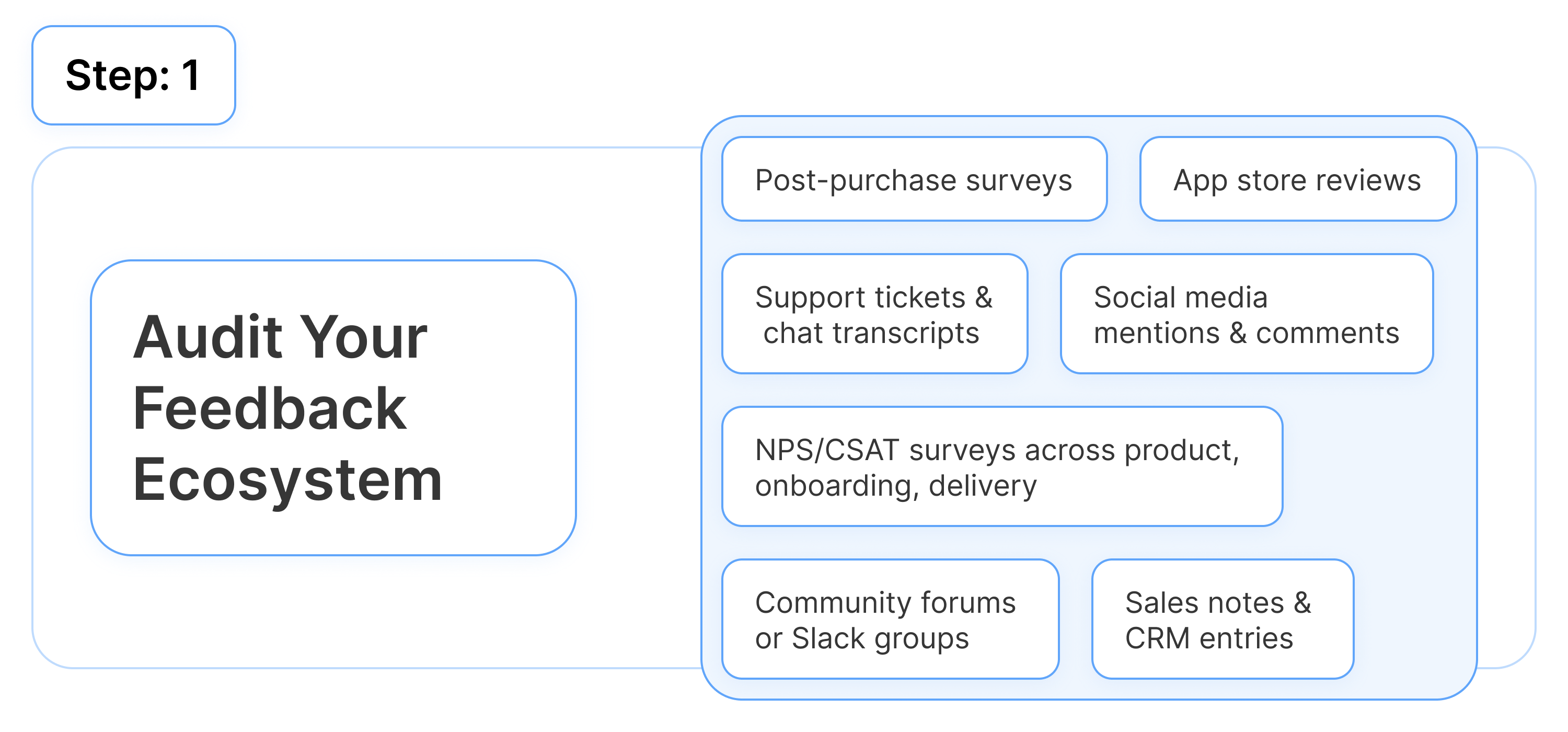
Step 2: Centralize & Standardize with AI
Once you’ve audited your feedback ecosystem, the next step is bringing it all together — not just into one place, but into one language. Because having 15 sources of feedback doesn’t help if each one speaks a different dialect.
That’s where centralization meets standardization. And this is where AI can save you hundreds of hours.
a. Break Down Channel Walls
Your feedback shouldn’t live in silos. Pull in everything — surveys, tickets, chat, reviews, social media, CRM notes — into a single, centralized feedback system. With AI tools like Zonka Feedback, this process is automated:
- APIs and integrations pull in feedback in real time
- Duplicate responses and irrelevant noise are filtered out
- Identity stitching links feedback to the right customer/account
b. Speak the Same Language with Standardized Themes
Now that your feedback lives in one place, you need to organize it into something readable and comparable. That’s where taxonomy comes in:
- The AI auto-tags comments into high-level themes like onboarding, support experience, pricing, delivery delays
- Standardize synonyms: “too expensive” and “pricing issue” will land in the same bucket by the AI
- Manually refine subthemes and tags over time or let AI learn and improve
💡With a thematic analysis tool like Zonka Feedback’s AI helps seed themes, spot new ones emerging, and keep your taxonomy tight without constant manual cleanup.
c. Set Identity & Access Rules
Don’t forget the glue: identity. Decide what your primary identifier will be — email, account ID, domain — and set fallback logic if data is missing. Also, define who can see what:
- Role-based views (e.g., product team sees feature themes, support sees detractor alerts)
- Privacy controls to redact sensitive data in verbatims
- Clear access rules so no feedback is “lost” behind permission walls
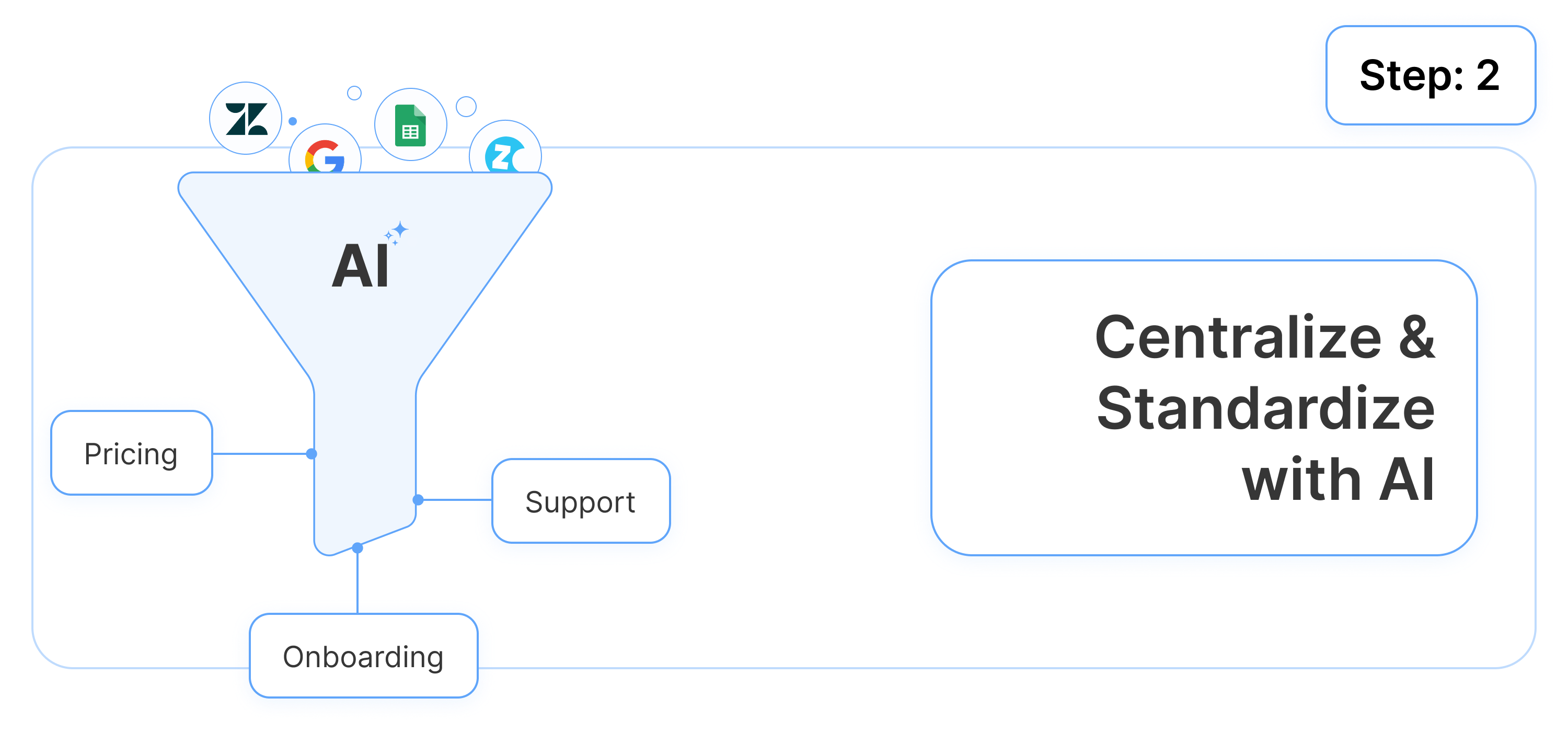
Step 3: Move from Dashboards to Decisions
Dashboards don’t drive change — people do. You can have the best charts in the world, but unless those insights trigger action, they’re just static slides in a CX review meeting. This step is about building a system where every meaningful signal turns into a task, someone owns it, and there’s a clear path to resolution.
a. Automate Feedback Workflows That Trigger Real Action
Don’t wait for someone to “notice” a trend. Let your system act the moment something important shows up.
Set up automated workflows so that key feedback instantly becomes:
- A ticket for support
- A backlog item for product
- An alert for customer success
Consider these examples:
- Delivery complaint from a top customer → auto-ticket in Zendesk, flagged as priority, routed to regional ops, SLA: 4 hours
- Recurring billing confusion → tagged and added to Product board with impact score
- NPS < 7 with “likely to switch” in verbatim → Slack alert to CS with pre-drafted outreach message
This turns “someone should look at this” into “someone’s already on it.”
b. Equip Teams with Role-Specific Playbooks
Each team engages with feedback differently. Instead of dumping raw data on everyone, provide tailored playbooks with next steps based on signal type and urgency.
- Support → Detractor response playbook: Acknowledge in 24 hours, categorize the issue, close the loop
- Product → Top feedback themes → root cause analysis → deploy fix → notify affected users
- Customer Success → Churn-risk accounts flagged → context + suggested message → reach out proactively
The goal at this stage is to turn insight into ownership. No confusion about who does what next.
c. Define the Finish Line for Every Feedback Type
Seeing the signal is just the beginning. What does “resolution” actually mean? Define “done” clearly:
- Bug report? → Fixed, tested, and confirmed live
- Policy friction? → Internal process updated + team informed
- Customer complaint? → Acknowledged, actioned, follow-up sent
Tracking these outcomes not only ensures feedback leads to change, it gives you proof that it did.
💡With Zonka Feedback, you don’t need 5 tools to make this happen. Assign tasks, set SLAs, trigger alerts, and close the loop — all in one place, or integrated with your existing systems.
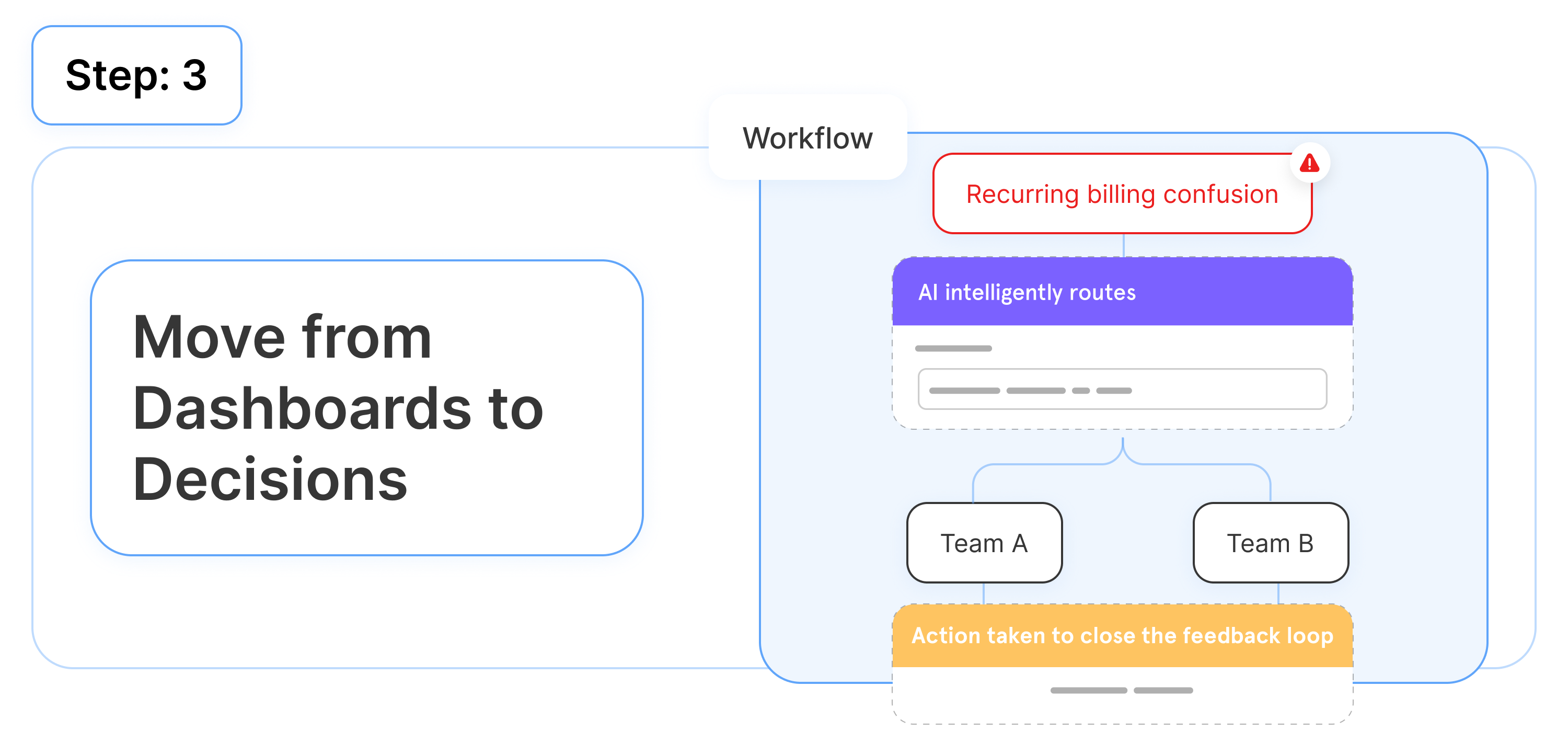
Step 4: Add Intelligence & Real-Time Alerts
You don’t need more notifications. You need the right ones, the kind that don’t add to noise but prompt action where it matters most.
That’s where intelligent alerts come in. Instead of reacting to issues after they escalate, you stay one step ahead — catching problems early, flagging churn risks, and even spotting broken processes in real time.
a. Set Smart Thresholds That Matter
Forget basic volume-based alerts. AI lets you monitor context, not just counts. Set up alerts that tell you:
- “Negative sentiment in app reviews spiked 45% in the last 24 hours”
- “Delivery complaints in the West region doubled week-over-week”
- “Payment failures among new users increased by 30% this week”
These aren’t just alerts, they’re early warning systems. Designed to catch the small stuff before it snowballs.
b. Route Signals to the Right People Instantly
Speed is only helpful when it’s paired with precision. Smart routing ensures the right signals land on the right desks fast. For instance
- Bug reports with high volume? → Auto-ticket in Jira, tagged by theme
- NPS < 7 from high-value customers? → Alert CS with context + ready-to-send reply
- Fulfillment issues in a region? → Ops pinged in Slack with urgency tag
Each alert should come with enough context to act, not just a red flag, but a response path.
c. Guard Against Alert Fatigue
Too many alerts = team burnout. That’s why smart alerting also means fewer, more meaningful pings. Add control features like:
- Quiet hours to protect focus time
- Minimum volume thresholds (e.g., “only if >10 comments per hour”)
- Cool-down windows to avoid duplicate alerts for the same issue
💡With Zonka Feedback, you can build intelligent alert rules, automatically route signals to the right team, and reduce alert fatigue — all while ensuring nothing critical slips through the cracks.
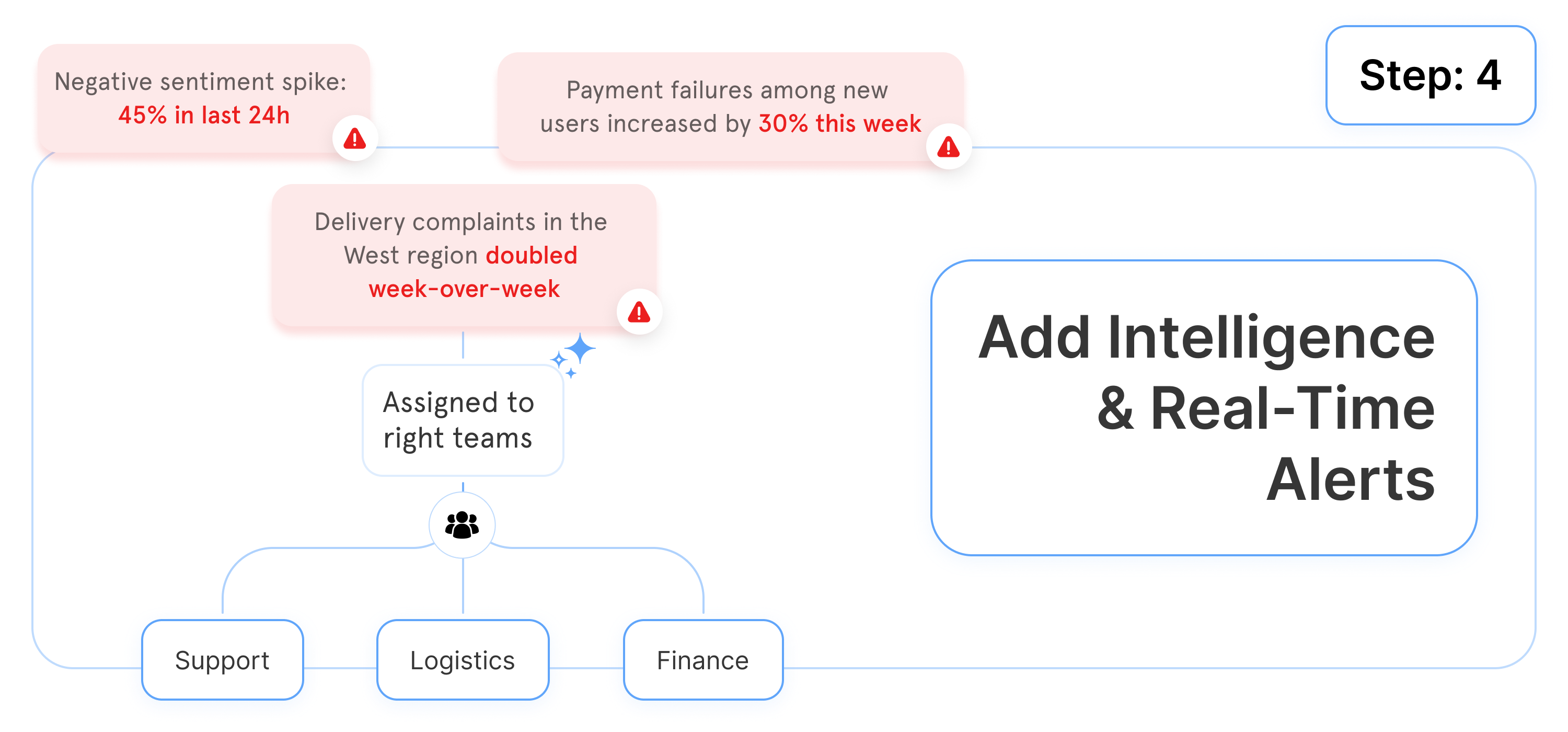
Step 5: Close the Feedback Loop & Prove ROI
Collecting feedback is easy. Acting on it is where most teams stop. But if you really want buy-in across the org, you need to go one step further, show that the action led to results. This is where most CX programs fall short. Not because they aren’t fixing things, but because they’re not proving the value of those fixes. Here's how you can change that.
a. Track What Changed and Why
Every action triggered by feedback should leave a trail. Set up a simple but powerful action log that captures:
- What changed? (e.g., product feature, internal process, customer policy)
- Why was it changed? (tie it to feedback theme, score drop, or customer segment)
- Who owned it? And when was it implemented?
This kind of traceability builds confidence — internally and externally.
b. Link Actions to Business Outcomes
Fixing something is great. But what did it achieve? Move beyond surface metrics like NPS and start connecting actions to real business results:
- Did your fix reduce support tickets?
- Did your new email bump onboarding completion rates?
- Did that detractor follow-up lead to a renewal?
By measuring the before and after, you turn feedback into business intelligence.
c. Share the Wins (and the Lessons)
Your feedback efforts shouldn’t stay in the CX team’s Slack channel. Turn them into wins your whole company sees:
- “Fixing the payment failure flow led to an 18% drop in support tickets”
- “Targeted CS follow-ups lifted renewals by 12% in high-risk accounts”
- “Real-time delivery alerts reduced 1-star reviews by 24% in just 10 days”
Even better? Use these wins to push for more resources, cross-functional support, or executive visibility.
Zonka's AI Feedback Intelligence makes it easy to log changes, connect them to outcomes, and turn feedback into proof of impact so your CX program isn’t just insightful, it’s indispensable.
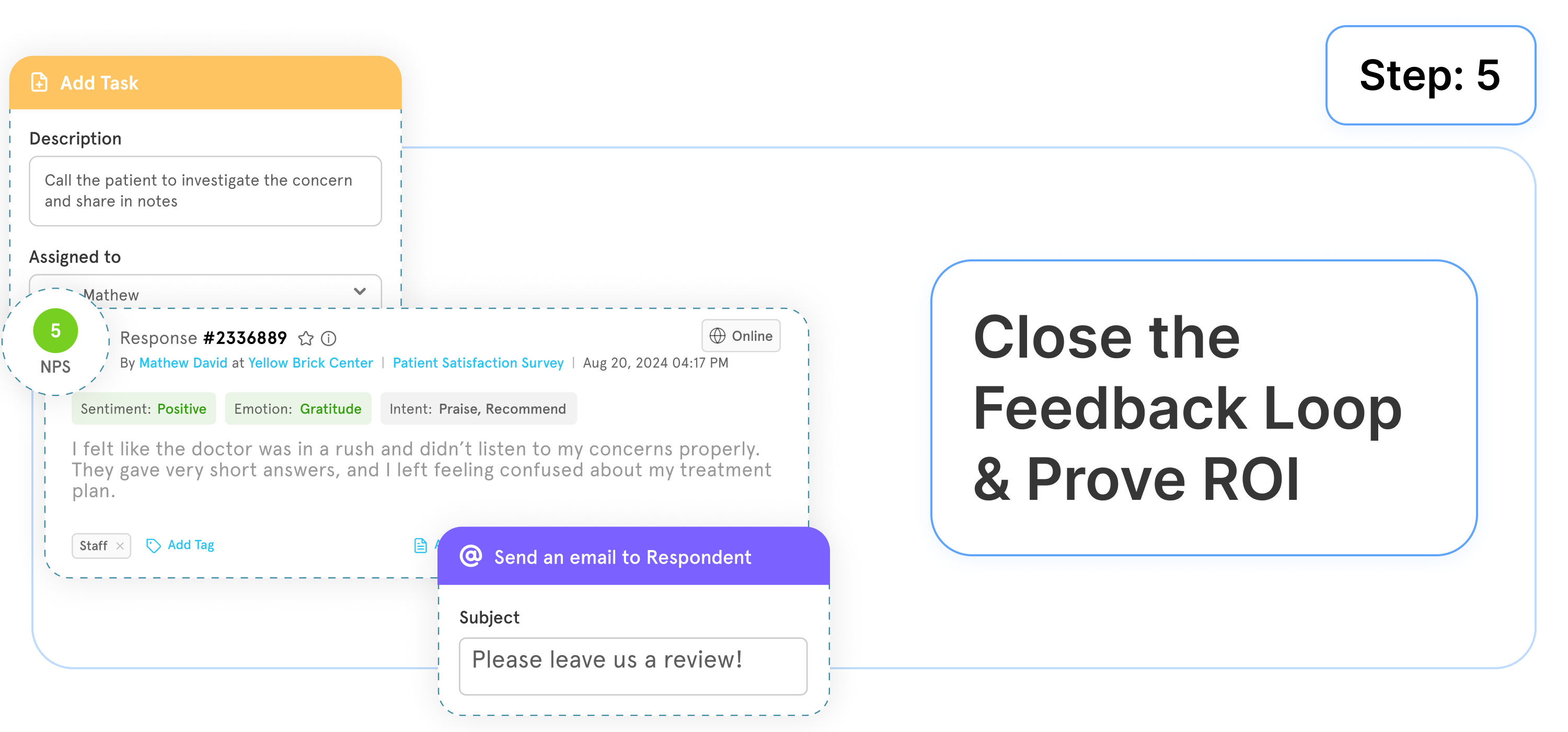
5 Metrics That Signal You’ve Built a Unified Feedback Engine
You’ve centralized the data, added intelligence, routed insights, and closed the loop. But how do you really know if your feedback system is doing its job, not just collecting noise, but fueling smart decisions?
These five metrics are the clearest signals that you’ve moved beyond fragmented feedback into true customer intelligence:
- Signal-to-Action Ratio (S→A): If 100 insights come in, how many are turned into owned, trackable actions? A strong S→A ratio — say, 70% or higher — means your teams aren't just monitoring feedback; they’re operationalizing it. With AI routing and triggers, this metric should climb steadily without manual intervention.
- Time-to-Insight: When delivery complaints spike or onboarding friction shows up, how long before the right team sees it? A modern AI feedback platform should reduce your time-to-insight to hours — not days or weeks. This enables preventive action, not just post-mortems.
- % Feedback Auto-Routed with Owner: The strongest feedback systems operate without constant human handholding. If 80–90% of relevant feedback is automatically routed (e.g., billing complaints → product team in Jira; detractor reviews → CS with context), you’ve achieved intelligent distribution — at scale.
- % Insights Tied to ROI Metrics: Insights don’t matter unless they move the needle. Your system should consistently tie themes and actions to outcomes like churn reduction, NPS uplift, or resolution time drops. For example: “Fixing the pricing experience issue led to a 14% lift in trial-to-paid conversions.”
- Closed-Loop Rate: It’s not just about resolution — it’s about closing the loop with those who gave the signal. A healthy closed-loop rate (over 60%) means feedback isn’t disappearing into a black hole. It’s being acknowledged, resolved, and communicated back — building customer trust and internal accountability.
These are the metrics your C-Suite cares about. They don’t just prove feedback is being collected — they show it's fueling growth, loyalty, and operational wins.
Conclusion
At the end of the day, fixing feedback silos isn’t just about improving CX dashboards, it’s about rebuilding trust. Because when a customer takes the time to tell you something and nothing happens, that’s not just a missed insight, that’s a missed opportunity to retain, to resolve, to connect.
You’ve seen how fragmented feedback holds your team back: duplicated work, missed trends, slow reactions, and frontline blind spots. But you’ve also seen what’s possible when you unify your ecosystem — real-time alerts, smart routing, proactive fixes, and measurable impact.
This isn’t about collecting more feedback. It’s about finally making all your feedback work together. Zonka Feedback is a customer experience tool that is purpose-built to make this happen — to help CX and product teams go from chaos to clarity. With intelligent routing, smart alerts, unified dashboards, and AI-powered insight engines, Zonka Feedback brings all your feedback together and turns it into outcomes.
If you’re ready to break the silos and start turning feedback into fast, meaningful action — now is the time. Schedule a demo and see how easy it is to unify your feedback, automate insights, and close the loop at scale.











